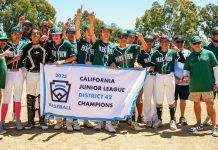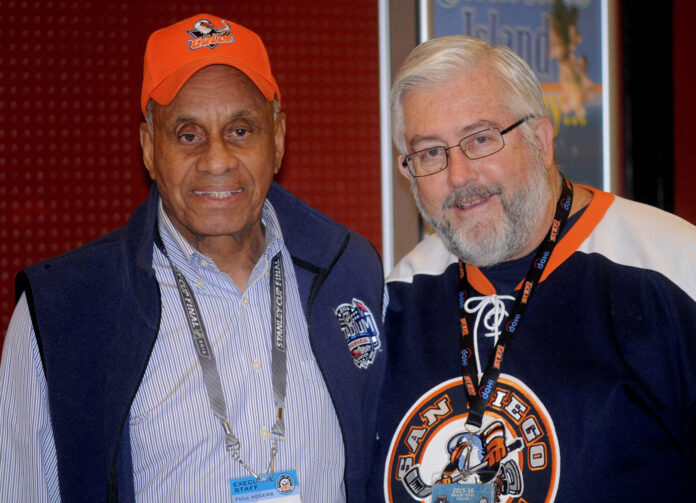
While hockey returned on multiple platforms during the COVID-19 pandemic, games were more times than not played in empty arenas.
Local fans were iced out of Pechanga Arena during the 2020-21 season because of COVID-19 protocols. The San Diego Gulls, the arena’s resident team, instead played its home games at the NHL parent Anaheim Ducks’ new practice facility in Irvine.
Area ice hockey fans had to settle for watching their favorite team on over-the-air television broadcasts or Internet streaming services.
That will change this season — and change for the better for the legion of fans who follow the sport.
The Gulls will face off the home portion of their 2021-22 American Hockey League schedule Oct. 22. Scott Hopkins, a former educator in the Chula Vista Elementary School District and now retired, plans to be in his customary seat a few rows up from the ice on Opening Night.
He’s not just a Gulls fan but a hockey fan first and foremost. He’s held season tickets to every team that has played in the arena since the puck first dropped on Nov. 17, 1966, with the arrival of the original San Diego Gulls of the Western Hockey League.
“It has been hard during the years San Diego hasn’t had a hockey franchise, but it’s even more frustrating when we have a team, but it is playing in another city with no fans in attendance,” he explained. “It will be like a school reunion when I put on my mask, show my vaccination card and walk through the doors of Pechanga Arena to take my seats four rows from the ice and once again become enthralled by the action of the world’s fastest team sport.”
He likely will not be the only one sharing that sentiment.
Expect both teams that night — the Gulls and their opponent, the Stockton Heat — to receive a standing ovation from fans as they skate onto the ice. It’s been 19 months since the puck last dropped at the arena.
Hopkins gets chills when he recalls his introduction to the sport.
“I was a student at Point Loma High School where my friends and I were sports lovers,” he recalled. “San Diego had been a pretty small sports town with the San Diego State College Aztecs football team coached by Don Coryell probably the top ticket in town. But things were changing with San Diego Stadium under construction in Mission Valley and the San Diego International Sports Arena being built along what was once Frontier Street on the site of former Navy housing.
“We made regular trips to the arena construction site to watch it go up, and it went up very quickly. The entire arena was built in one year at a cost of $6.4 million with private funding from local sports legend Bob Breitbard.
“Many people don’t realize the playing surface of the arena is below ground level. A huge pit was dug as part of the construction process and soon after the steel beams went up. We laughed at a port-a-potty that was placed atop the highest steel beam, wondering who could possibly have the nerve to use it!”
Hopkins paid 75 cents for a general admission student discount ticket for the WHL Gulls’ first-ever game. He was joined by more than 11,000 other San Diegans from a city population of about 500,000.
“When the game began, we had no idea what these men were doing on the ice,” Hopkins recalled. “They skated up and down with amazing speed, ran guys into the boards. Often times they used their sticks to control the puck with great skill. Sometimes someone was shoved or pushed into the metal wire fencing above the boards, one of the cost-saving measures taken. Of course, every other arena had Plexiglass and there were many times players were bloodied after an encounter with the wire fencing.”
The Gulls were an instant hit. Fans have been cheering the sport here ever since. They will be especially vocal when the latest edition of the Gulls hits the ice.
Memory lane
The San Diego region was much different a half-century ago.
“At that time in local history, the Chargers were the only ‘major’ sports team we had and that status was challenged because their American Football League was considered inferior to the established National Football League,” Hopkins said. “The Padres were a minor league team playing at Westgate Park, now the site of Fashion Valley shopping center.”
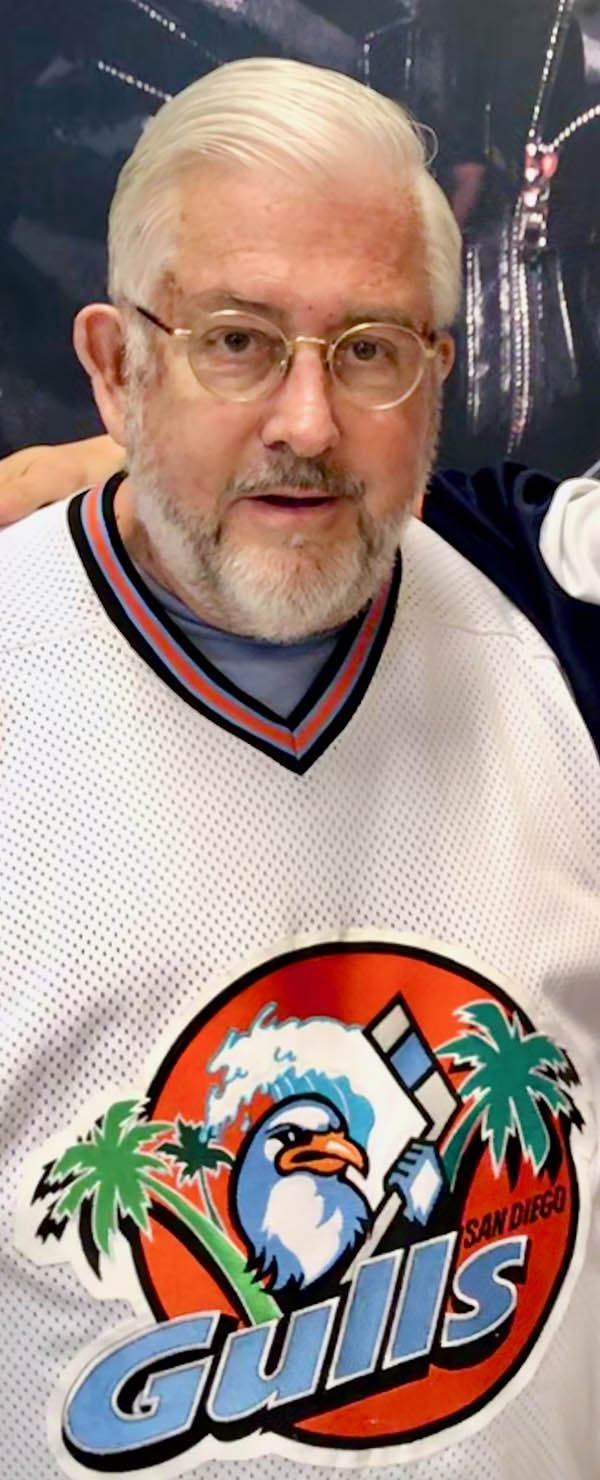 Because the arena was still being finished by the time the WHL’s 1966-67 season faced off, the fledgling Gulls played their first games on the road until the new arena was ready to open its doors to the ticket-buying public.
Because the arena was still being finished by the time the WHL’s 1966-67 season faced off, the fledgling Gulls played their first games on the road until the new arena was ready to open its doors to the ticket-buying public.
The Gulls defeated the Seattle Totems, 4-1, in their first home game.
The Gulls’ original coach was MaxMcNab. One of his sons, Peter, would go on to post a 15-year career in the NHL with Buffalo Sabres, Boston Bruins, Vancouver Canucks and New Jersey Devils, accumulating 813 points in 954 regular season games.
Gulls players were led onto the ice by team mascot Sandy Gull (an adult in a Gulls costume) and a young child (Gulliver Gull), also dressed in a Gulls costume.
“There was a catchy theme song played by the arena organist before every period and the national anthem was regularly sung by Mary Ann Escamilla,” Hopkins recalled. “Each game added more and more to a Gulls tradition that the people of San Diego loved and wanted more of.
“Also, back then no players wore helmets, including goalkeepers and most of the men in the nets were scarred, some very badly.
“But the game was fast; there were few breaks and never did players stand around like in other sports. After a while we figured out what offsides and icing were and enjoyed the game more and more. By the end of that first game, I was hooked. I had to come back to see more of this blazing fast game.”
During the Gulls’ inaugural season, there were only six NHL teams instead of 32 today, which meant that the original Gulls’ roster was comprised of NHL-caliber players, as the Gulls served as a minor league affiliate to the NHL level.
Hopkins can still recall many of the names from those early Gulls teams.
Jack Evans played 346 games before later becoming the team’s coach. John MacMillan (360 games), Al LeBrun (348), Warren Hynes (290), Fred Hilts (274), Gerry Goyer (281), Alex Faulkner (208), Edgar Ehrenverth (333), Len Ronson (446), Bob Courcy (276) …and then there were the Gulls legends: Al Nicholson, a beloved player (434 games) who died soon after his playing days were over.
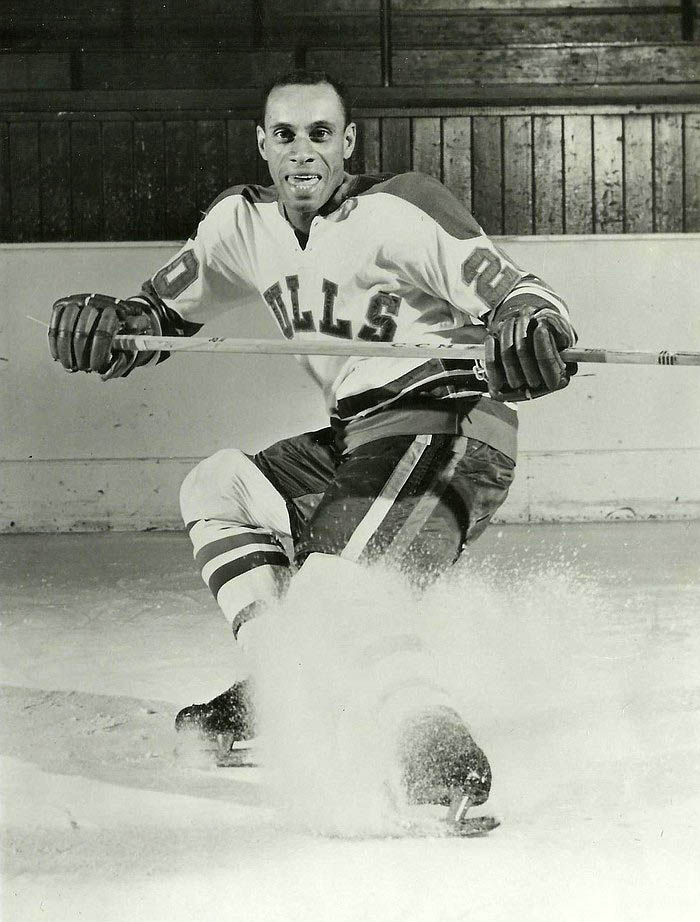
But the most beloved Gull of any team in local history is Willie O’Ree, who played 407 games as an original Gull and is fondly remembered as the “Jackie Robinson of pro hockey.” O’Ree was the first black player to skate in the NHL and now, into his early 80s, still lives in San Diego (La Mesa) and has become a member of the Hockey Hall of Fame. O’Ree still attends Gulls games and never turns down an autograph request or a chance to chat with fans.
Those were legendary times indeed.
Hopkins was a student at San Diego State College (now SDSU) by the time the Gulls’ first season ended but he was determined to miss as few games as possible.
“One night, while studying for a final, I skipped a playoff game against the Portland Buckaroos and was listening on the radio,” Hopkins said. “Portland had an ‘enforcer’ named Connie ‘Mad Dog’ Madigan. Whenever he had the puck on his stick, fans would begin barking loudly and it was quite funny. But when Madigan was assessed a penalty by referee Dave Newell he slugged the referee and knocked him unconscious on the ice. Ironically, the hated Madigan played 39 games for the Gulls in their final Western Hockey League season. The fans still barked at him but interestingly loved his rough and intimidating play.”
When Hopkins graduated from college in 1972, he purchased his first-ever season tickets in Lower Level, Section 7, in the second row up from the ice.
The close vantage point provided additional observational material for the young hockey fan.
“The speed of the game was amazing,” Hopkins recalled. “I could see the facial expression of the players and the shots, at nearly 100 mph, came straight at me. I quickly learned to trust the fencing to keep me safe, but we laughed as people threw food and drinks on themselves in panic as the rock-hard rubber disk came straight at them and they instinctively reacted to protecting themselves.”
The WHL Gulls had a marriage made in heaven with local hockey fans for eight years (1966-74) until the league folded as the major leagues eventually made their way to the west coast.
The Gulls were followed by the San Diego Mariners of the World Hockey Association (1974-77), San Diego Mariners of the Pacific Hockey League (1977-78), San Diego Hawks of the Pacific Hockey League (1978-79), San Diego Surf of the Pacific Southwest Hockey League (1988-93), San Diego Gulls of the International Hockey League (1990-95), San Diego Gulls of the West Coast Hockey League (1995-2003), San Diego Gulls of the ECHL (2003-06) and current iteration of the Gulls (2015 to present).
There have been five franchises that have carried the Gulls moniker, including the current one.
There have been two noticeably long breaks without hockey in town, from 1979 to 1990 (11 years) and from 2006 to 2015 (nine years).
Many fans cried when the puck was first dropped for the IHL Gulls’ opener at the arena after an absence of more than a decade.
There was a similar reaction when the AHL moved five franchises westward to create the new Pacific Division of which the Gulls (originally the Norfolk Admirals) were charter members. The AHL’s proximity to the NHL has helped greater interest among the Gulls’ fan base, with many players at the AHL level earning call-ups or permanent promotion to NHL rosters, particularly that of the Ducks.
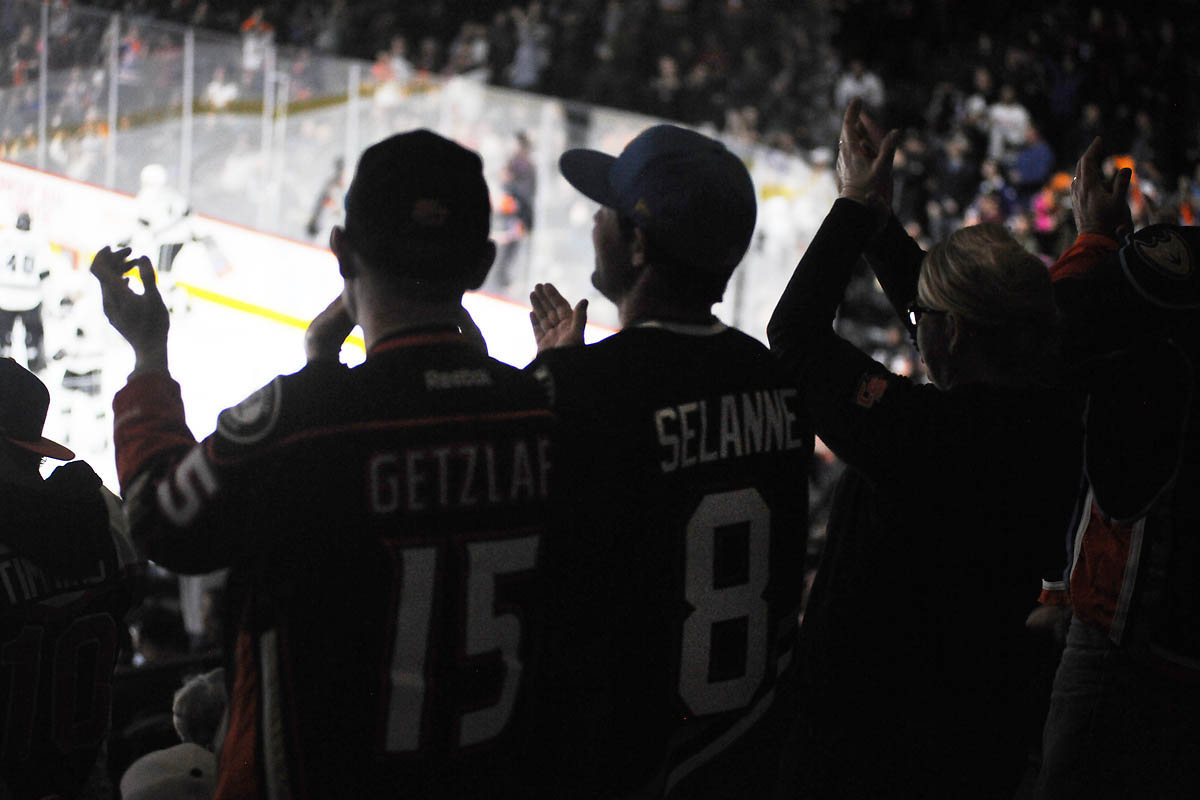
But pangs of nostalgia persist for Hopkins.
“Other memorable players included crafty Andre Lacroix with the Mariners and former New York playboy Ron Duguay, who was talked out of retirement to play for the West Coast Hockey League Gulls,” Hopkins recalled.
Those formative years of hockey in San Diego also created its own culture among fans.
“In the early years and again when other hockey franchises came to the arena we were like a big family in my section,” Hopkins noted. “Many of us chatted during intermissions and eventually started taking turns bringing candy to pass around. Then we added a Guess the Attendance event with each entry costing $1. The closest guess won the pot and everyone enjoyed playing and taunting the winner.”
Because of its near non-stop nature, hockey had a hard time transitioning to over-the-air television broadcasts that depended on commercial breaks for revenue. That has now been solved by cable television networks and online viewing packages. The sport is definitely unique — perhaps a cross between basketball and soccer on ice.
(When the San Diego Sockers moved to play indoors at the arena during the early 1980s, they found an instant fan base of hockey fans for support.)
“As for the game itself, it is one of few that allows players to enter and leave the game without a stoppage in play,” Hopkins pointed out. “The action is non-stop as coaches try to keep ‘fresh legs’ on the ice. The puck moves with lightning speed as players make pass after pass looking for the player with the best shot.
“It is the skill of the players and the speed of the game that, for me, makes it special. The ability to skate, control the puck, look for teammates, make passes and shoot the puck on the forehand or backhand is something beyond what virtually all fans can imagine doing themselves.
“The games move quickly with three 20-minute periods and intermissions of about 20 minutes between periods. True fans enjoy the breaks as times to chat with friends, stroll the concourse and perhaps hit a snack stand or grab a refreshing beverage. From start to finish, most games last about two-and-a-half hours unlike football, and especially baseball that can go on and on.
“And, of course, hockey has fighting, something that seems to bring out the best and worst in fans. For many years fighting was allowed —possibly encouraged — and each team had an ‘enforcer’ to protect their top scorers. The on-ice officials (one referee and two linesmen in the early days) would usually let the combatants fight until one had an unfair advantage or one was exhausted or hurt. The home team’s fighters always heard thundering cheers as they went to the penalty box or were ejected from the game.
“Fighting has been significantly reduced and players are now much bigger than my first years as a fan. Players in the 1960s were rarely as tall as six feet. Now, many are over six feet and some as tall as 6 feet, 9 inches, who move as fast as smaller players.”
Hopkins has had the opportunity to meet numerous Gulls players over the years. “While they are primarily minor league players, they are the most humble and pleasant of athletes to deal with, happy to talk with fans and pose for photos,” Hopkins said. “They are not full of themselves and most grateful for the fans who have come to watch them play. And yes, some of them are missing a tooth or several teeth.”
There have been cries for an NHL team to come to San Diego. Hopkins recalls vividly how it almost happened in the early 1970s when the hockey world recognized San Diego as the city with the highest attendance in minor league hockey.
“We were set to be awarded an expansion team (in 1974) when then-general manager of the arena, Peter Graham, worked a deal to bring a failing World Hockey Association team, the New Jersey Knights, west to become the San Diego Mariners. That ended our NHL dreams.”
But NHL dreams continue for the current crop of Gulls.
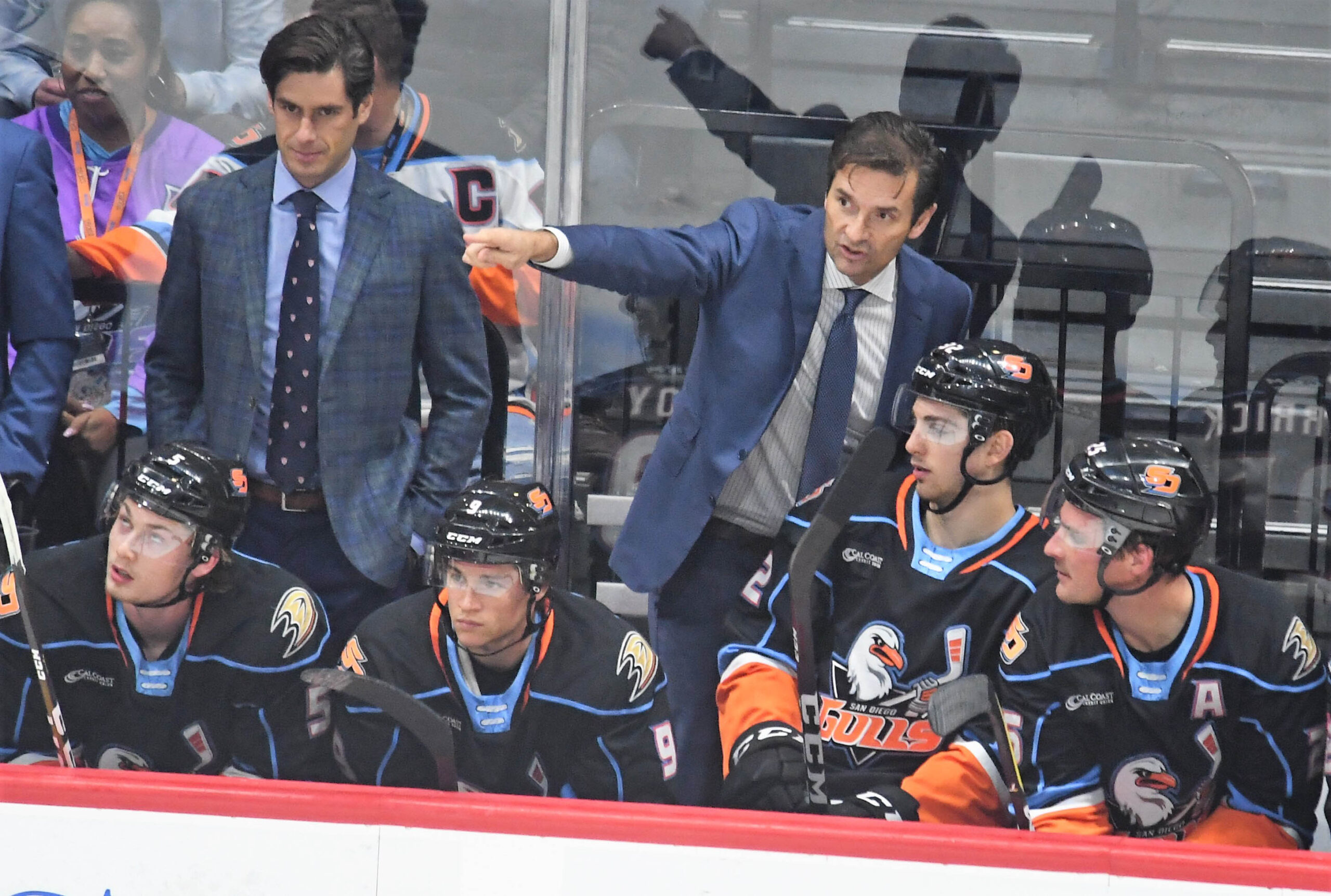
Taking flight
The Gulls face off the 2021-22 season with a game Saturday, Oct. 16, against their Southern California archrival, the Ontario Reign, at Toyota Arena in Ontario. This will be the seventh season for the Gulls franchise, its sixth playing in front of local fans at Pechanga Arena.
The Gulls enter their regular season opener after sweeping both preseason contests against the Reign — 4-2 on Oct. 6 in Ontario and 5-2 on Oct. 11 at the Honda Center in Anaheim, the parent Ducks’ home arena.
San Diego and Ontario met 10 times during the AHL’s shortened 2020-21 season, with the Gulls posting a 7-3 record.
San Diego will see its third head coach in franchise history behind the bench this season as Joel Bouchard replaces Kevin Dineen after two seasons. Dallas Eakins coached the Gulls for their first four seasons in the AHL before being promoted to head coach of the Ducks in June 2019.
Dineen recorded a 56-36-7-2 record in two seasons in San Diego before his contract was not renewed. He promptly landed on his feet in Utica, N.Y., following a franchise relocation and affiliation change with the New Jersey Devils.
Bouchard comes over from the Laval Rocket where he found success there last season as Canadian Division regular season champions and an 83-67-24 record over three seasons.
Bouchard sees his assignment with the Gulls as developing players who Eakins can rely on when called up to the NHL.
“I want to make sure I push the right button to make sure they become the best NHL player they can become or the best version of themselves,” Bouchard said. “I’m very detail-oriented and demanding. Everything is a process. It’s our job to create a winning environment.”
Bouchard came up a winner in his Gulls’ coaching debut, albeit in the preseason as Alex Limoges and Jacob Perrault each scored a goal and assist and San Diego newcomer Brogan Rafferty netted the game-winner midway through the third period. Vinni Lettieri scored an empty net goal with 10 seconds left to secure the Oct. 6 preseason win.
Limoges, Rafferty, Lettieri, Bryce Kindopp and Kodie Curran (empty net) all scored to brace the Gulls’ winning effort in the Oct. 11 return match.
Olle Eriksson Ek stopped 26 of 28 shots he faced to pick up the goaltending win in the preseason opener while Lukas Dostal stopped 23 of 25 pucks fired in his direction to post the victory in the teams’ preseason rematch.
Dostal, a a third-round pick in the 2018 NHL Entry Draft by Anaheim, is expected to be the Ducks’ goaltender of the future. He certainly made his rookie season a memorable one by posting a 15-9 record with a 2.87 goals-against average and .916 save percentage in 24 games with the Gulls in Irvine.
While more than a half-dozen players rostered with the Gulls last season made this year’s Ducks’ Opening Night roster, there is still plenty of talent to spread around the ice at Pechanga Arena.
Fans will have plenty of time to pick out their favorites to cheer for.
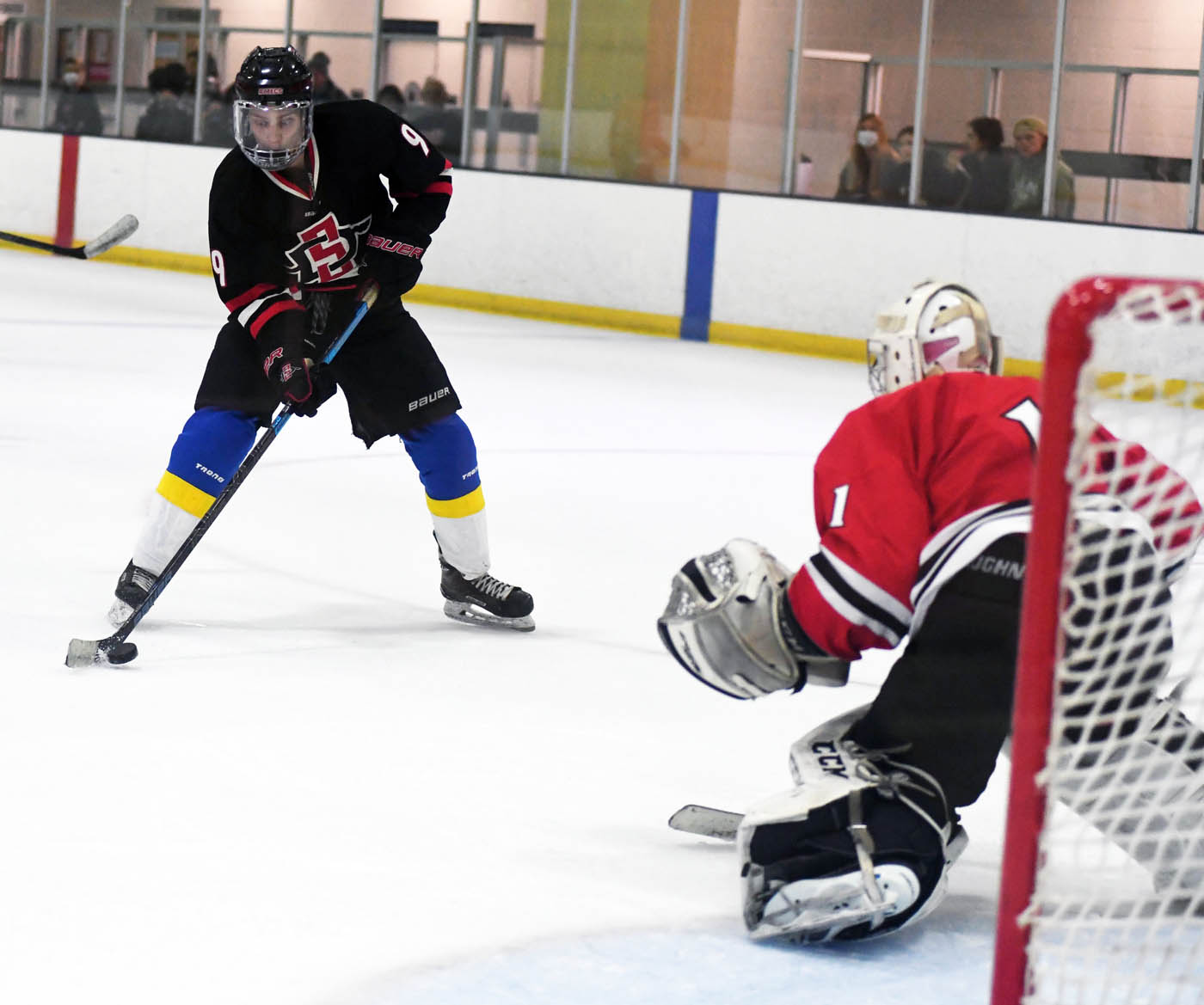
Red and Black is forever for these SDSU ice alumni
The San Diego State University men’s ice hockey team hit the ice Oct. 8-9 at the Kroc Center Ice Arena, though it wasn’t against Colorado State University as originally planned.
CSU cancelled the weekend series against the Aztecs, leaving SDSU head coach Phil Bateman “scrambling,” in his words, to fill the team’s dates at the ice rink, SDSU’s home venue.
Bateman came up with a winning lineup on short notice that actually proved to be quite entertaining.
The Aztecs hosted an old-fashioned Red-Black intra-squad scrimmage on Friday and closed the weekend with an alumni game on Saturday.
The Red-Black Game featured nine goals, with the Red team pulling out a 6-3 victory. The alumni game was even more wild with 20 goals scored between the teams. The alumni led early but the varsity team came back to post an 11-9 victory.
“That is always a fun event, getting to see the past guys play the current crop,” Bateman said. “The alumni paved the way for where we are today, so it’s important to keep that connection to the past.”
Alumni who committed to play included Eastlake High School alumnus Aaron Mayer and Otay Ranch High School alumnus Devyn Taras, SDSU teammates for two seasons (2018-19 and 2019-20). Prior to that they were adversaries on the roller rink in the CIF-Metro Conference.
Mayer holds the record for most points scored in one season while Taras, suiting up for the rival Mustangs, often proved to be a thorn in the side of the Titans.
Mayer paced the alumni with three goals and one assist. He opened scoring in the game, assisted by Taras.
“It was like a flashback,” Taras said with a grin. “It was nostalgic. Aaron was always burying the puck and I was supplying the assists. It was supposed to be like that. I’m glad it turned out that way.”
Mayer, who played parts of five seasons at SDSU, wasn’t done by any means. He scored again to stake the alumni to a 2-1 lead on a nifty reverse wrap-around.
He scored on a breakaway in the third period to tie the game at nine.
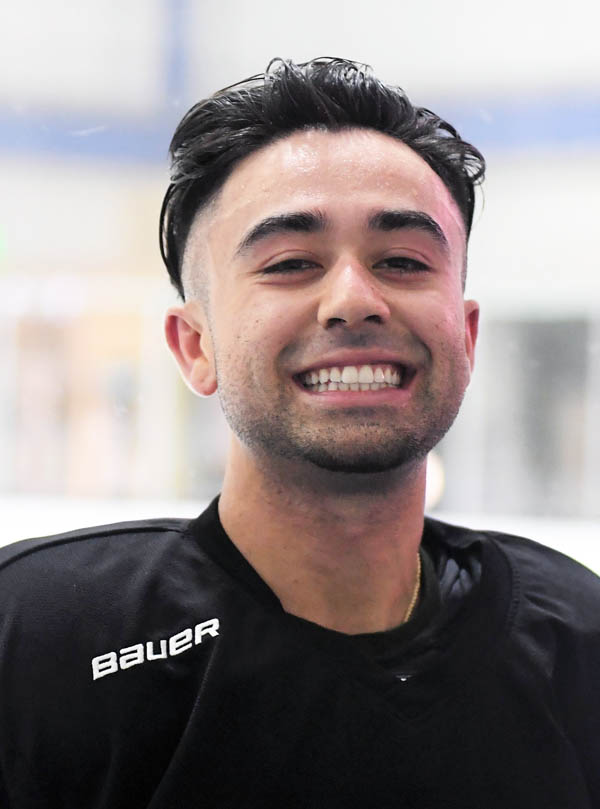
Taras remains as feisty as ever on the ice. He said he was proud to represent the program once again. He just wished he could have played longer in a varsity uniform.
“Unfortunately, I only played two years because the COVID-19 pandemic wiped out my senior year,” he said. “The memories I take along with me are mostly about hanging out with the boys on trips, staying in hotels, passing the time, all fun times.”
Like many ice hockey players, Taras first gained traction on wheels in roller hockey. “I started off with roller hockey when I was 5-6 years old, then later made the transition to ice,” the one-time Otay Ranch star said. “I started here (at the Kroc Center). It’s like coming full circle because I finished my college career here.”
Mayer has been on skates nearly all his life. He started skating at 3 or 4 and started hockey at 4 or 5 at the Kroc Center.
“I’ve been playing hockey for over 20 years,” he said. ““I picked it up over time; I’ve played just about everywhere in California.”
Mayer saw the SDSU program grow to where it is now. The Aztecs faced off the 2017-18 season 10-0-1. SDSU recorded its first 20-win season in program history in 2019-20, Mayer’s last season with the team.
“It’s gotten a lot better, a little more serious,” Mayer said. “When I first came, it was more all about having fun. Now it’s about winning games.”
Mayer continues to make the Kroc Center his second home by coaching youth teams there since October 2015. He’s currently coaching Squirt, Pee Wee and Bantam in-house teams and a Squirt B travel team.
He calls it giving back to the community while acting as a role model.
“I’m teaching kids about the things I learned,” he said. “I like to watch the kids emulate that. Some of the parents send me little clips of what I showed the kids in practice and the kids applying it in actual games. It makes me feel so good. It makes my day.”
SDSU games typically follow youth games at the centrally-located rink.
Bateman feels the Aztecs need to become embedded in the local hockey community.
“I want that jersey to mean something,” the SDSU coach said.
It does.




